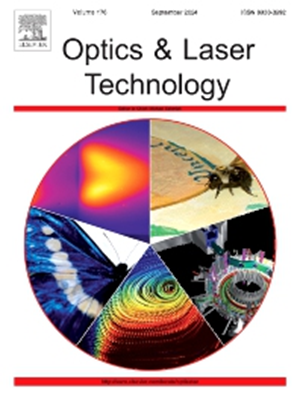A telecentric-perspective heterogeneous stereo vision system and its calibration
IF 4.6
2区 物理与天体物理
Q1 OPTICS
引用次数: 0
Abstract
The telecentric lens is highly efficacious for precise and detailed measurements, yet typical telecentric stereo vision systems face a significant challenge due to the limited overlapping Depth Of Field (DOF) between their two telecentric cameras. A Heterogeneous Stereo Vision System (HSVS) is developed for three-dimensional (3D) measurement, which consists of a telecentric and a perspective camera. The depth-invariant property of the telecentric imaging and the relative wider coverage of the perspective vision jointly facilitate the 3D measurements in some specific scenarios. A novel methodology for calibrating the HSVS is proposed, in which the pose ambiguity of the telecentric camera is solved in a more concise way. In addition, the stereo geometry parameters are optimized under the transformation consistency constraint to improve the accuracy and robustness. Experiments show that the proposed HSVS preserves high accuracy (an average distance deviation of 0.012 mm) within a relative lager working volume than that of a stereo vision system composed of two telecentric cameras.
远心视角异构立体视觉系统及其标定
远心镜头对于精确和详细的测量非常有效,但典型的远心立体视觉系统由于两个远心相机之间有限的重叠景深(DOF)而面临重大挑战。提出了一种用于三维测量的异构立体视觉系统(HSVS),该系统由远心相机和透视相机组成。远心成像的深度不变性和相对较宽的视角覆盖范围共同促进了某些特定场景下的三维测量。提出了一种新的远心相机位姿模糊标定方法,该方法可以更简洁地解决远心相机的位姿模糊问题。此外,在变换一致性约束下对立体几何参数进行了优化,提高了精度和鲁棒性。实验表明,该系统在相对较大的工作体积内保持了较高的精度(平均距离偏差为0.012 mm),比由两个远心相机组成的立体视觉系统的工作体积要大。
本文章由计算机程序翻译,如有差异,请以英文原文为准。
求助全文
约1分钟内获得全文
求助全文
来源期刊
CiteScore
8.50
自引率
10.00%
发文量
1060
审稿时长
3.4 months
期刊介绍:
Optics & Laser Technology aims to provide a vehicle for the publication of a broad range of high quality research and review papers in those fields of scientific and engineering research appertaining to the development and application of the technology of optics and lasers. Papers describing original work in these areas are submitted to rigorous refereeing prior to acceptance for publication.
The scope of Optics & Laser Technology encompasses, but is not restricted to, the following areas:
•development in all types of lasers
•developments in optoelectronic devices and photonics
•developments in new photonics and optical concepts
•developments in conventional optics, optical instruments and components
•techniques of optical metrology, including interferometry and optical fibre sensors
•LIDAR and other non-contact optical measurement techniques, including optical methods in heat and fluid flow
•applications of lasers to materials processing, optical NDT display (including holography) and optical communication
•research and development in the field of laser safety including studies of hazards resulting from the applications of lasers (laser safety, hazards of laser fume)
•developments in optical computing and optical information processing
•developments in new optical materials
•developments in new optical characterization methods and techniques
•developments in quantum optics
•developments in light assisted micro and nanofabrication methods and techniques
•developments in nanophotonics and biophotonics
•developments in imaging processing and systems

 求助内容:
求助内容: 应助结果提醒方式:
应助结果提醒方式:


